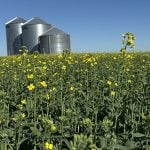A six-year streak of hitting record export values for Canadian beef is an impressive feat with total beef exports reaching $4.5 billion in 2021! We are proud to be a world leader in producing high-quality, sustainable beef, with over 50 per cent of our production being exported to over 58 countries. Trade adds significant value to our industry as producers have gained approximately C$1,044 per animal on a five-year average through selling in international markets. But our work is far from done — we want to continue to grow exports of Canadian beef through new trade agreements and resolve trade-limiting factors in current agreements.
It’s hard to believe that we’ve just passed the first anniversary of Canada achieving bovine spongiform encephalopathy (BSE) negligible risk status. This was a tremendous milestone for our industry and the work continues to open export opportunities and remove remaining BSE-era export restrictions.
As we transition to BSE negligible risk status, two important considerations will continue to affect our market access: alignment of specified risk material (SRM) removal with the U.S. and removal of the remaining BSE market access barriers such as limits on over-thirty-month (OTM) cattle.
Read Also

The Canadian Cattle Association’s international advocacy efforts
Global ag policies affect Canadian food policy, so the Canadian Cattle Association participates in international and domestic forums
We are continuing our efforts to gain equivalency with the U.S. when it comes to SRM removal and disposal. The additional estimated cost of SRM removal and disposal in Canada in comparison to the U.S. is over $35 million per year.
To optimize our trade potential, market access is critical to numerous markets for Canadian beef where BSE-era restrictions remain. We continue to collaborate with the Government of Canada to remove the remaining BSE restrictions in accordance with international guidelines.
In our view, diversification of markets and the removal of non-tariff barriers are key to rules-based, sustainable trade and the continued growth of the Canadian beef sector, and ultimately the Canadian economy.
Significant and persistent market access barriers continue to negatively affect the Canadian beef industry and the broader agricultural sector, which in turn can have a ripple effect on the government’s ambitious goal of achieving $85 billion in agri-food exports by 2025.
Key to our industry’s growth is the Indo-Pacific region, an important and fast-growing export market for agricultural commodities — including beef. With a growing middle class, gross domestic product (GDP) and food consumption, this region is a high-growth market and one of Canada’s best opportunities for trade. About 20 per cent of Canada’s beef exports are destined for the Indo-Pacific region, with the top five markets last year being Japan, mainland China, South Korea, Vietnam and Hong Kong. There are also further opportunities for Canadian beef in markets such as Indonesia, the Philippines and Thailand.
In this region, we need to focus on increasing our presence and capacity to proactively address and prevent market access issues. One way this could be accomplished is through the creation of a new Indo-Pacific Diversification office with a mandate to prevent and resolve agricultural market access issues. This work would complement the efforts of local staff in the region in providing much-needed technical resources to address new and ongoing market access issues, deepen connections, support regional capacity-building and prevent new trade barriers from arising. This is an important step the Government of Canada can take to increase our presence, market access and trade capabilities in the region.
Canada has seen successes and trade growth following the implementation of the Canada-United States-Mexico Agreement, Canada-Korea Free Trade Agreement and the Comprehensive and Progressive Agreement for Trans-Pacific Partnership (CPTPP).
As we look at new trade agreements currently being negotiated, our highest priority is achieving a long-term ambitious free trade agreement with the U.K. These negotiations provide an opportunity to resolve existing trade-limiting factors with provisions that will better serve Canada’s beef farmers, ranchers and packers who have been subject to unequal trading conditions through the Comprehensive and Economic Trade Agreement that were then carried over to the Canada-U.K. Continuity Agreement.
For example, the trade balance for 2021 was -$8.7 million in favour of the U.K. Unless progressive trade outcomes are achieved and aligned with international trade standards, Canadian beef exports to the U.K. will remain unviable. To grow our trade relationship, beef industries in Canada and the U.K. must enjoy equal access and mutual benefit. CCA is committed to working with the Canadian government on the Canada-U.K. trade relationship and will continue to provide input in the upcoming rounds of negotiations to establish science-based, progressive trade parameters, such as those contained in the CPTPP.
Despite the many challenges in the industry and international trade, including the COVID-19 pandemic, our success on the trade front continues. As the world continues to open to travel, we look forward to meeting in person with our national and international industry partners to advance our trade priorities and visiting with current and potential customers around the globe.
May we all look forward to a summer of excellent pasture land and healthy cattle!
















